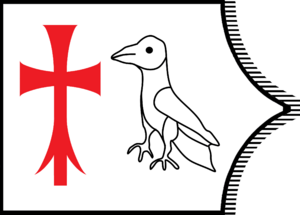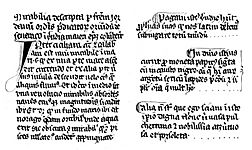Jordanus facts for kids
Quick facts for kids Jordan of Severac |
|
|---|---|
| The first Roman Catholic bishop in India (Bishop of Quilon India) |
Jordanus (active around 1280 to 1330), also known as Jordan of Severac or Jordan of Catalonia, was an important explorer and Christian missionary. He was a Dominican friar from Catalonia, a region in Spain. Jordanus traveled widely in Asia and wrote a famous book called Mirabilia Descripta. This book described the amazing things he saw in the East. He also became the first Roman Catholic bishop in India, leading the Diocese of Quilon.
Contents
Jordanus's Journeys to Asia

Jordanus was probably born in Sévérac-le-Château, a town in France. He might have traveled to the East with another missionary, St. Thomas of Tolentino, around 1302. However, we know for sure that Jordanus was in western India by 1321. He was with Thomas and his friends.
Sadly, they faced trouble in Thane, near Mumbai. Jordanus's companions were killed there in April 1321. Jordanus managed to escape.
Working in India
After escaping, Jordanus worked for some time in Bharuch, in Gujarat, and also near Surat. He wrote two letters to his fellow Dominicans in Persia. The first letter was from Gogo in Gujarat (October 1321). The second was from Thane (January 1323/4). These letters described how his new mission was going.
From his letters, we know that people in Europe were interested in the Mumbai area. They also cared about the very south of India, especially a place called Kollam (also known as Quilon or Columbum). Jordanus's words suggest he might have started a mission there even before October 1321.

Jordanus learned from Catholic traders that Ethiopia (which included parts of Africa like Abyssinia and Nubia) could be reached by Europeans. At that time, other missionaries were also starting to go there. Jordanus, like others, asked the Pope to create a Christian navy in the Indian seas.
Becoming a Bishop
Between 1324 and 1328, Jordanus likely visited Kollam. He probably chose it as the best place for his future work. It seems he also went back to Europe around 1328. He traveled through Persia and possibly stopped at a port called Sudak.
In 1328, Jordanus was made a bishop. Pope John XXII officially appointed him as the bishop of Kollam on August 21, 1329. This was a very important event! The Diocese of Quilon became the first Roman Catholic diocese in all of the "Indies." Its area covered modern India, Pakistan, Afghanistan, Bangladesh, Myanmar, and Sri Lanka.
Mirabilia Descripta: Jordanus's Book of Wonders
Jordanus likely wrote his book, Mirabilia Descripta (which means "Description of Wonders"), either before he became a bishop in India or during a later visit to Europe. This book was written between 1329 and 1338.
In Mirabilia, Jordanus gave the best description of India from any European during the Middle Ages. His account was even better than Marco Polo's! He wrote about India's regions, products, climate, and the ways of life of its people. He also described the animals and plants he saw.
Jordanus divided India into three parts in his book. "India Major" included the coastal lands from Malabar to Cochin China. "India Minor" stretched from Sind (or Balochistan) to Malabar. "India Tertia" was a large, undefined coastal area west of Balochistan, reaching towards Ethiopia.
Jordanus's Mirabilia also has the first clear description of "Prester John" as an African ruler. It might also be the first time the "Black Sea" was called by that name. The book mentions Jordanus living in India Major, especially in Kollam. He also traveled in Armenia, Persia, and other regions. He gave excellent descriptions of the Parsee religion, Hindu worship, and Indian fruits, birds, animals, and insects. We don't have any more information about Bishop Jordanus I after April 8, 1330.
Excerpts from Mirabilia Descripta
-
Jordanus's thoughts on the Saint Thomas Christians in India, from his book Mirabilia Descripta.
-
Jordanus writing about the "Turkish Saracens" in India, from Mirabilia Descripta.
See also
 In Spanish: Jordanus Catalani para niños
In Spanish: Jordanus Catalani para niños
- Chronology of European exploration of Asia






